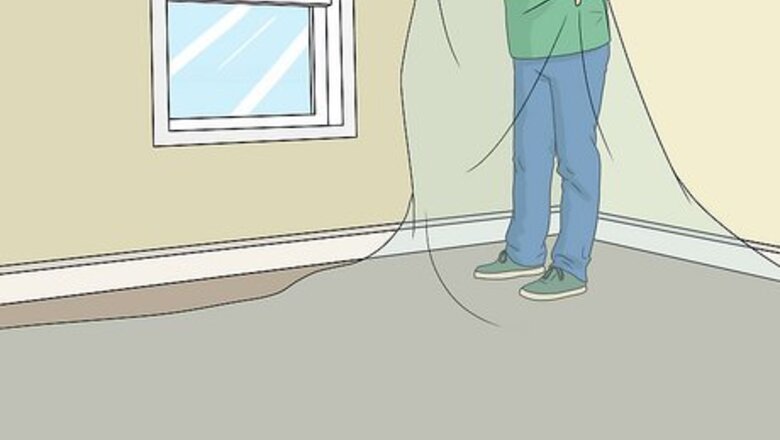
views
Cleaning the Ceiling
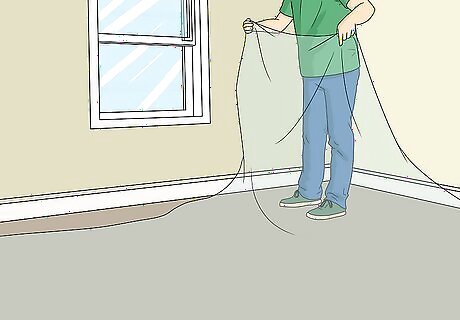
Cover the floor with a drop cloth to protect it from paint. The drop cloth will also catch the peeling paint as you remove it. Position it under the area with the peeling paint. If your ceiling has a couple of damaged spots far apart, cover the floor under each one. Drop cloths are available online and at your local hardware store. You can use plastic or canvas. For easier cleanup, get a trash can as well. While you can use it to help pin down the drop cloth, it comes in handy for throwing away chunks of peeling paint.
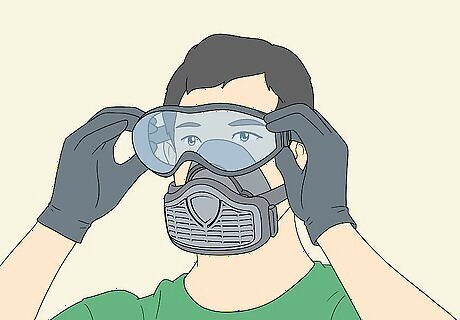
Put on goggles and a dust mask before working on the ceiling. An N95 disposable dust mask is fine, but you can also wear a full face mask if you wish. Pair it with simple safety goggles that keep your eyes well-covered. Wear them on while you’re removing the old paint as well as while you’re applying the new paint. To help eliminate some of the dust and paint fumes, open nearby doors and windows. Turn on ventilation fans if you happen to have any in the room. Warn other people to stay out of the room while you’re working. Keep pets out as well.
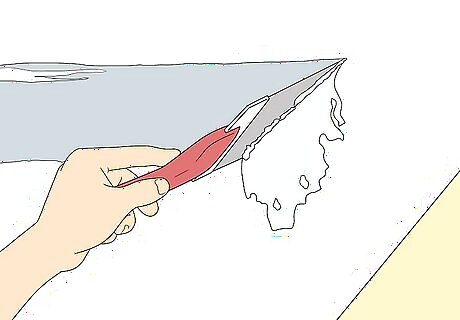
Use a paint scraper to remove all of the loose paint. Set up a small step ladder that allows you to safely reach the ceiling. Hold the paint scraper at about a 30-degree angle from the ceiling, then push it toward the loose paint. Try to remove enough paint to expose the underlying surface. You won’t have to remove any of the old paint that is still intact. Some other tools you can use include a putty knife, wire brush, or an all-in-one painter’s tool.
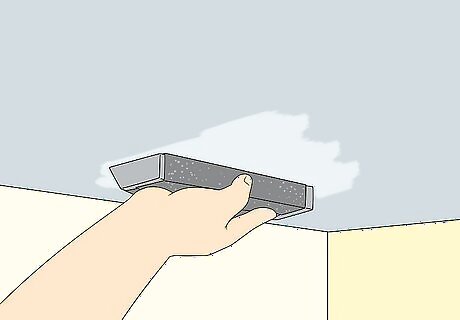
Scrub the ceiling lightly with 150-grit sandpaper. Go over the entire area you exposed by removing the old paint. Also, rub down the edges of the existing paint, since they will likely end up with a little bit of the patching compound on them. Scrub very lightly, enough to rough up the ceiling without leaving scratches. Doing this helps the patching compound and fresh paint stick. If the sandpaper leaves noticeable scratches, chances are that you’re scrubbing too hard. Use a light touch, but make sure you sand everywhere. You won’t have to sand the rest of the ceiling unless you’re planning on painting it as well.
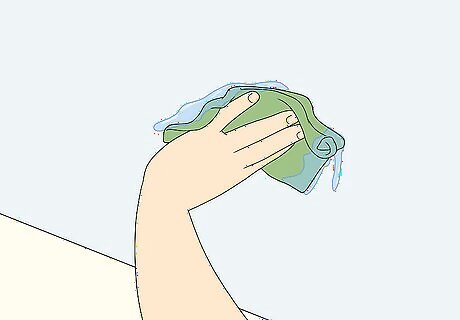
Wash the ceiling with clean water. Fill a small bucket with warm water, then scrub the ceiling with a soft sponge or lint-free cloth. Remove any dust left from sanding the ceiling. Also, take care to eliminate any noticeable stains, since they can also prevent the fresh patch from adhering. If you need a stronger solution to remove tough stains, try mixing 1 teaspoon (4.9 mL) of dish soap and 2 tablespoons (30 mL) of white vinegar into 1 cup (240 mL) of warm water.

Dry the ceiling off completely with a clean, lint-free cloth. After wiping the ceiling dry, check for any remaining debris or moisture. If the ceiling isn’t dry, the paint may crack again. It is also possible for dust and stains to show up underneath paint. When painting, it is always better to work with a fresh surface. If necessary, take the extra time to get the ceiling back into good condition.
Applying a Patching Compound
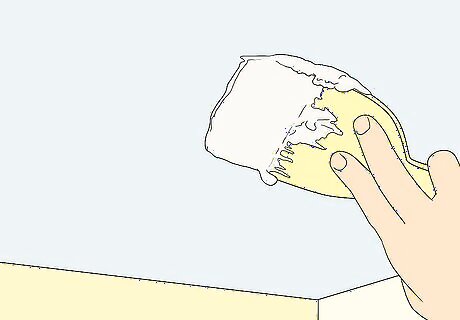
Fill in any cracks or holes with a patching compound. Select a quick-setting patching compound. It doesn’t need to be mixed at all, so scoop up a large clump of it with a putty knife. To apply it, hold the knife at about a 30-degree angle to the ceiling and drag it across the area you’re repairing. Start on one side and gradually work toward the opposite side with overlapping strokes until the ceiling is covered with a layer of compound about ⁄8 in (0.32 cm) thick. Approach the bare area from a few different directions. For example, try spreading the patching compound along its length, then go back across its width to flatten it out. Remove excess material by wiping the paint scraper off on the edge of the compound’s container. Make sure the compound isn’t too thick, or else the repair may not turn out as consistent as it should.
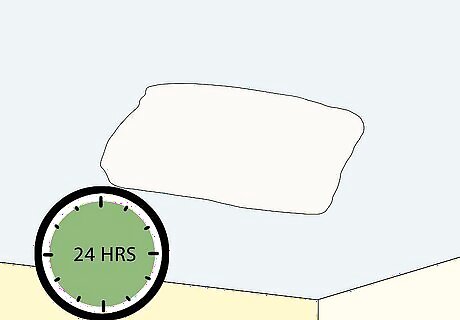
Wait 24 hours for the patching compound to dry. It has to be completely dry before you can do anything else with it. Let it rest overnight and plan on finishing the repair the next day. Make sure no one else touches the wet compound in the meantime. If you are unable to finish the repair right away, you can leave it alone. It will be fine. However, dust will settle on the ceiling over time, so be sure to wipe it clean with a dry rag before continuing.
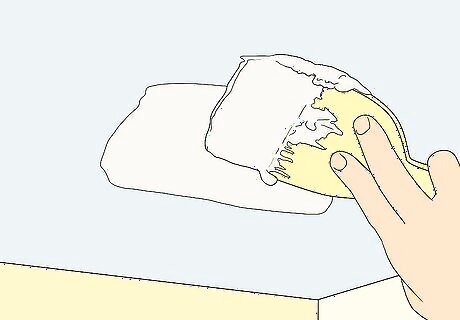
Apply a second coating of patching compound if it is needed. Check the patching compound to make sure the repaired area matches the rest of the ceiling. It should be roughly level with the surrounding areas. If it isn’t, use your putty knife to spread another ⁄8 in (0.32 cm)-thick layer. Make sure holes, cracks, and other trouble spots are so well-covered that you can no longer see them. Apply as many layers of compound as necessary to repair the damage. You may have to apply more than 2 to hide the bare spot. Always let the patching compound dry before adding another layer. If you end up having to add multiple layers, this will take a while, but it’s worth it. The paint may peel again if you don’t let the base layers dry out.
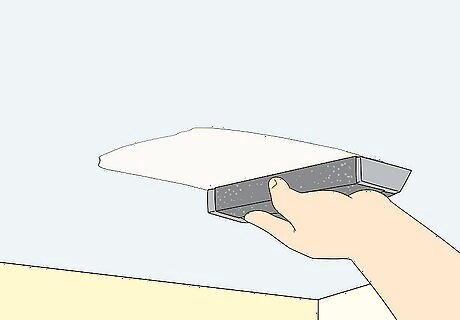
Use 150-grit sandpaper to blend in the patch with the rest of the ceiling. Press the sandpaper to the ceiling with a light amount of pressure. Gently work your way across one edge of the patch. Work your way in lines across the entire patch, but don’t overlap areas you have already sanded. Put some extra effort into sanding the edges to ensure they are flat and even with the existing paint. When you’re done, feel the patch with the tips of your fingers. Check for any areas that feel rough or elevated. Flatten them out in preparation for the paint. Any raised area left behind will show up underneath the paint. If you wish to hide the patch, make sure it’s even all over and consistent with the rest of the ceiling.

Wipe the area clean with a clean sponge dampened in warm water. Lightly dampen the sponge instead of soaking it. The patch will have plenty of dust on it from the sanding you did. Even if you can’t see it at first, it’s there, so wipe off the entire patch. Check it over when you’re done to make sure it’s completely clean. The patch should look bright and fresh when you’re done. If it doesn’t look right, you may need to clean it again or even it out with another layer of the patching compound.

Dry the ceiling off with a clean lint-free cloth. Remove all moisture on the ceiling so that the paint doesn’t end up buckling as soon as you apply it. You can test the patch afterward by touching it to make sure it feels dry. Take some extra time to check it over again for any signs of debris, including dust. Once the ceiling is clean and dry, you can begin painting it. The best strategy is to start painting right after you finish cleaning the ceiling so that dust and other debris doesn’t have time to settle. If you have to wait, dust the ceiling clean right before painting it. If you’re waiting until later to start painting, clean up the room, such as by vacuuming up any dust left over from before.
Priming and Painting the Ceiling
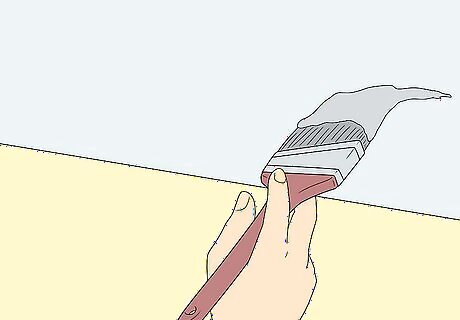
Brush an oil-based primer over the damaged area on the ceiling. To prevent the repaired spot from cracking again, make sure you get a good stain-blocking primer. Try using a flat-bristle paintbrush. Dip the bristles into the primer, then hold the brush against the ceiling. Press down with a light amount of force so the bristles bend slightly. Then, drag the brush along the length of the repaired spot, painting it gradually without overlapping your strokes. For larger areas, switch to a medium ⁄8 in (0.95 cm) nap polyester paint roller. If you are able to get an extension pole, it will help you reach the ceiling without having to balance on a ladder.
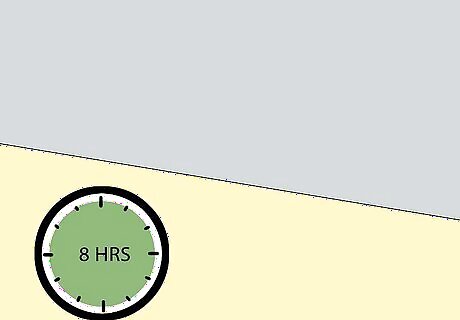
Wait about 8 hours for the primer to dry. When you finish applying the primer, check the manufacturer’s instructions on the paint can. Oil-based primers can take a decent amount of time to cure, so make sure you wait long enough for it to completely dry out. Make sure it at least feels dry to the touch before attempting to paint over it. You can safely let the primer dry overnight and then paint it the next day. If any dust gets on it before then, just wipe it clean with a dry cloth. The primer has to be completely dry before you can paint over it. If it isn’t dry, the new paint could crack, forcing you to start all over again. This is a good time to remove old supplies and clear the room of dust, such as by vacuuming.
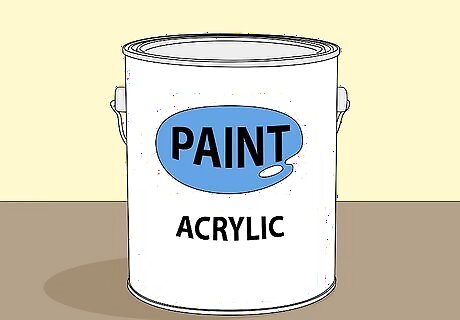
Select a quality acrylic paint that matches the rest of the ceiling. Make sure you choose a moisture-resistant paint that is compatible with oil-based primers. If you have some paint leftover from when the ceiling was first painted, use it to ensure the patch blends in seamlessly. Otherwise, try getting a paint sample close in color to what is already on the ceiling. You could take a picture of your ceiling or bring in a paint chip to your nearest paint supplier. Ask them for help color matching. Blending new and old paint can be a little tricky. One way to avoid this is by repainting the entire ceiling.
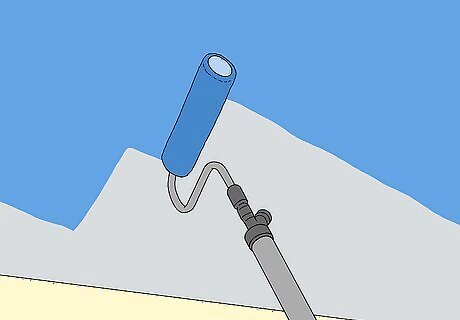
Paint over the patch from the center outward with a brush or roller. Coat the brush or roller lightly to avoid using too much paint. If you’re using a brush, lift it up gently as you move it toward the edges. Doing this will keep the paint thin so the patch blends in better. Apply more paint as needed to cover the patch. To make this much quicker and easier, consider using a roller. Rollers leave a smoother, more even finish than brushes do. Use the tips of the bristles to apply a light coating of paint along the edges of the patch. This is called feathering. It can be tough to master, but, when it’s done correctly, it does a great job of blending new paint in with old paint.
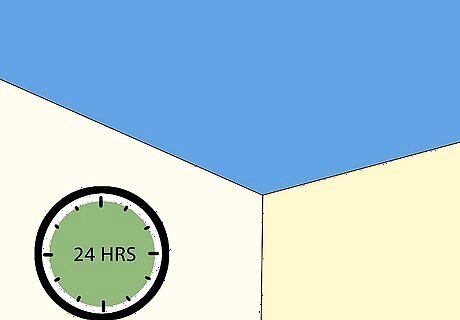
Let the paint dry for 24 hours to complete the repair. If you’re in the bathroom or another room that gets a lot of moisture, keep the ceiling dry until then. Avoid using the shower or anything else that increases the room’s humidity. Once the paint has finished drying, it will be more resistant to water damage. You can then go back to your daily routine, but don’t forget to take a few breaks to admire your beautiful ceiling. If the finished surface doesn’t look right, you could sand it and paint it again. Apply additional coats of paint if necessary to blend in the patch. You could also try refreshing the entire ceiling with a new coat of pain. If you haven’t already, clean up any remaining supplies and dust in the room to ensure the new finish is as high-quality as it possibly can be.




















Comments
0 comment